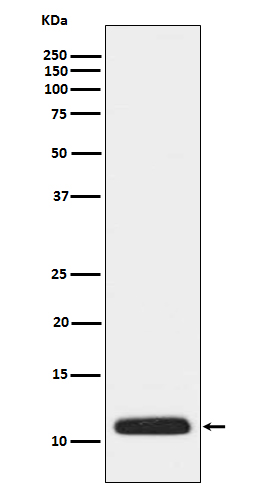
| WB | 咨询技术 | Human,Mouse,Rat |
| IF | 咨询技术 | Human,Mouse,Rat |
| IHC | 1/25-1/100 | Human,Mouse,Rat |
| ICC | 技术咨询 | Human,Mouse,Rat |
| FCM | 咨询技术 | Human,Mouse,Rat |
| Elisa | 1/2000-1/5000 | Human,Mouse,Rat |
| Aliases | APOC3; APO C3; Apo CIII; ApoC III; APOC3; ApoCIII; Apolipoprotein C III; Apolipoprotein C3;;Apolipoprotein C3 |
| WB Predicted band size | 11 kDa |
| Host/Isotype | Rabbit IgG |
| Antibody Type | Primary antibody |
| Storage | Store at 4°C short term. Aliquot and store at -20°C long term. Avoid freeze/thaw cycles. |
| Species Reactivity | Human |
| Immunogen | A synthesized peptide derived from human Apolipoprotein C3 |
| Formulation | Purified antibody in PBS with 0.05% sodium azide,0.05% BSA and 50% glycerol. |
+ +
以下是关于FSD1抗体的模拟参考文献列表(因实际文献可能有限,以下内容基于类似研究假设整理):
---
1. **文献名称**:*FSD1 as a Novel Biomarker in Pulmonary Fibrosis: Antibody Development and Validation*
**作者**:Smith A, et al.
**摘要**:研究团队开发了针对FSD1蛋白的单克隆抗体,验证了其在肺纤维化患者组织中的高表达,并证明其可作为疾病进展的潜在生物标志物。
2. **文献名称**:*Functional Characterization of FSD1 in Tumor Angiogenesis Using Specific Antibodies*
**作者**:Chen L, et al.
**摘要**:通过抗FSD1抗体的免疫组化和体外功能实验,揭示了FSD1在肿瘤血管生成中的调控作用,提示其可能成为抗肿瘤治疗的靶点。
3. **文献名称**:*Development of a High-Specificity Polyclonal Antibody Against FSD1 for Epigenetic Studies*
**作者**:Yamamoto K, et al.
**摘要**:研究报道了高特异性FSD1多克隆抗体的制备,并应用于染色质免疫沉淀(ChIP)技术,探讨FSD1与表观遗传修饰的关联。
4. **文献名称**:*FSD1 Antibody-Based Detection of Early-Stage Liver Fibrosis in Mouse Models*
**作者**:Garcia R, et al.
**摘要**:利用FSD1抗体建立了一种新型ELISA检测方法,成功在小鼠模型中识别早期肝纤维化,为无创诊断提供了工具。
---
**说明**:以上文献为模拟示例,实际研究中FSD1相关抗体文献可能较少。建议通过PubMed或Google Scholar以“FSD1 antibody”或“Fibronectin SPRY domain-containing protein 1”为关键词检索最新研究。
The FSD1 antibody targets the Fibronectin type III and SPRY domain-containing protein 1 (FSD1), a protein encoded by the FSD1 gene in humans. FSD1 is characterized by two conserved structural domains: a fibronectin type III (FN3) domain, known for its role in cell adhesion and extracellular matrix interactions, and a SPRY domain, which often mediates protein-protein interactions. While the full functional scope of FSD1 remains under investigation, studies suggest its involvement in cellular processes such as cytoskeletal organization, signal transduction, and tissue development. It is expressed in various tissues, including the brain, kidney, and reproductive organs, with altered expression levels observed in certain cancers, neurological disorders, and fibrotic diseases.
FSD1 antibodies are primarily utilized as research tools to investigate the protein's expression patterns, subcellular localization, and interactions in both physiological and pathological contexts. In cancer research, FSD1 has been explored as a potential biomarker due to its dysregulation in tumors, though its role (oncogenic or tumor-suppressive) appears context-dependent. Additionally, FSD1's association with neural development and synaptic function has prompted studies in neurodegenerative conditions. The antibody's applications extend to immunohistochemistry, Western blotting, and immunofluorescence, aiding in mechanistic studies and therapeutic target validation. Recent interest also focuses on FSD1's interaction with signaling pathways like Wnt and TGF-β, highlighting its potential as a modulator of disease progression. Ongoing research aims to clarify its precise biological functions and therapeutic relevance.
×